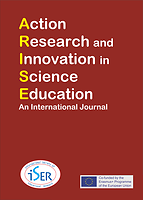Introducing infrared cameras in the study of pigs’ physiology and health as cognitive apprenticeship in vocational education
DOI:
https://doi.org/10.51724/arise.38Keywords:
biology education, secondary education, educational/instructional technologies, ICT, TPACK, instructional design, action researchAbstract
As part of a participatory action-research project, students at the vocational upper-secondary Natural Resource Use programme in Sweden were introduced to infrared cameras in their courses. Students were video recorded as they used infrared cameras in the investigation of pigs’ physiology and health in the school’s pig house and explained generated infrared images in whole-class dialogue, together with involved teachers and researcher. Students found that a pig’s injured leg has high temperature, but also, more surprisingly, udder abcesses with lower temperature than the surrounding healthy udder tissue. Students and teachers expressed excitement in explaining the results. From the perspective of seeing vocational education as a kind of cognitive apprenticeship, students’ investigations and dialogue with the teachers and researcher are characterised as an example of authentic activity in a community of learners, where expertise was distributed across all participants.Downloads
References
Berg, L.-E., Bergsten, C., Folestam, S., Henriksson, F., Karlsson, T., Länsberg, J., Mogren, P., Westlund, A., & Haglund, J. (2020). Introduktion av värmekameror i undervisningen vid Lillerudsgymnasiet. Karlstads universitet. Retrieved 23 November 2020 from http://urn.kb.se/resolve?urn=urn:nbn:se:kau:diva-79945
Brown, A. L., & Campione, J. C. (1994). Guided discovery in a community of learners. In K. McGilly (Ed.), Classroom lessons: integrating cognitive theory and classroom practice (pp. 229-270). Boston: MIT Press.
Brown, J. S., Collins, A., & Duguid, P. (1989). Situated cognition and the culture of learning. Educational Researcher, 18(1), 32-42.
de Bruijn, E., & Leeman, Y. (2011). Authentic and self-directed learning in vocational education: Challenges to vocational educators. Teaching and Teacher Education, 27(4), 694-702. https://doi.org/10.1016/j.tate.2010.11.007
Derry, S. J., Pea, R. D., Barron, B., Engle, R. A., Erickson, F., Goldman, R., Hall, R., Koschmann, T., Lemke, J. L., Sherin, M. G., & Sherin, B. L. (2010). Conducting video research in the learning sciences: Guidance on selection, analysis, technology, and ethics. Journal of the Learning Sciences, 19(1), 3-53.
Domin, D. S. (1999). A review of laboratory instruction styles. Journal of Chemical Education, 76(4), 543-547.
Eilks, I. (2018). Action research in science education: A twenty-year personal perspective. Action Research and Innovation in Science Education, 1(1), 3-14.
Gilbertsson, M., Lind, A.-K., & Tersmeden, M. (2019). Värmekamerans användning inom jordbruket. Research Institutes of Sweden. Retrieved 4 February 2020 from http://docplayer.se/154824305-Varmekamerans-anvandning-inom-jordbruket.html
Haglund, J., Jeppsson, F., Hedberg, D., & Schönborn, K. J. (2015). Students' framing of laboratory exercises using infrared cameras. Physical Review Special Topics - Physics Education Research, 11(2), 020127. https://doi.org/10.1103/PhysRevSTPER.11.020127
Haglund, J., Jeppsson, F., & Schönborn, K. J. (2016). Taking on the heat - a narrative account of how infrared cameras invite instant inquiry. Research in Science Education, 46(5), 685-713. https://doi.org/10.1007/s11165-015-9476-8
Haglund, J., & Schönborn, K. J. (2019). The pedagogical potential of infrared cameras in biology education. The American Biology Teacher, 81(7), 520-523.
Lave, J. (1991). Situated learning in communities of practice. In L. B. Resnick, J. M. Levine, & S. D. Teasley (Eds.), Perspectives on socially shared cognition (pp. 63-82). Washington: APA.
Lave, J., & Wenger, E. (1991). Situated learning: Legitimate peripheral participation. Cambridge University Press.
Lindberg, V. (2003). Learning practices in vocational education. Scandinavian Journal of Educational Research, 47(2), 157-179.
Skolverket. (2012). Upper Secondary School 2011. Skolverket. Retrieved 28 September 2020 from https://www.skolverket.se/publikationsserier/styrdokument/2012/upper-secondary-school-2011
Soerensen, D. D., & Pedersen, L. J. (2015). Infrared skin temperature measurements for monitoring health in pigs: a review. Acta veterinaria scandinavica, 57(5), 1-11.
Swedish_Veterinary_Association. (2017). Guidelines for the use of antibiotics in production animals: cattle, pigs, sheep and goats. Swedish_Veterinary_Association. Retrieved 28 September 2020 from http://www.svf.se/media/vd5ney4l/svfs-riktlinje-antibiotika-till-produktionsdjur-eng-2017.pdf
Säfström, I. (2019). Being close to a cow – Experiences of learning and farming among students at an agricultural program [Master's Thesis, Swedish University of Agricultural Sciences]. Uppsala, Sweden. Retrieved 28 September 2020 from http://stud.epsilon.slu.se/14961/1/safstrom_i_190827.pdf
Downloads
Published
Versions
- 10/01/2021 (2)
- 05/31/2021 (1)
How to Cite
Issue
Section
License

This work is licensed under a Creative Commons Attribution-NonCommercial-NoDerivatives 4.0 International License.
Copyright © Authors









